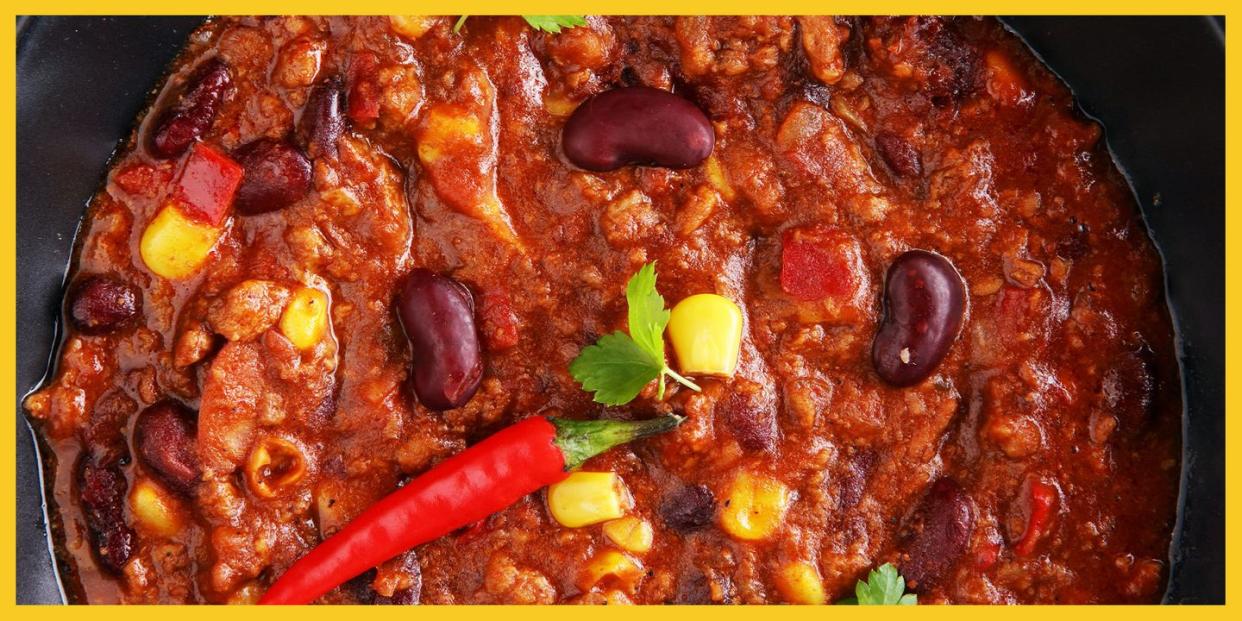The Secrets To Making Sure Your Chili Never Turns Out Watery

There's no better dish to make for the Super Bowl than a steaming bowl of chili. Whether you're cooking a batch of classic Texas Red, creamy white chicken chili, or even cinnamon-spiced Cincinnati chili, the end result is universal: hearty, comforting, and most importantly, thick.
The worst penalty in football isn't pass interference—it's watery chili. Without a sturdy foundation, all of your toppings will sink to the bottom. And, depending on other factors, a thin chili may mean that your game-day dinner will be bland and boring.
But fear not—a watery pot of chili doesn't have to ruin your night. There are plenty of solutions that'll transform your stew from blah to next-level delicious. We're unpacking all of our favorite Delish-approved tips so you can decide which one works best for your batch of chili.
Higher Heat
Often times, the best way to fix a thin chili isn't by adding extra ingredients. It's patience. The source of your woes is ultimately just water, which will evaporate when exposed to heat. So just raise the heat and keep simmering on the stove uncovered so your chili has more time to cook off the excess liquid.
There are a few things to consider with this techniques. Firstly, you need to be more vigilant when it comes to stirring. The higher heat might cause some burning at the bottom of the pot, so you need to keep the chili moving to prevent that from happening. The next concern should be the salt level of your chili. If your chili is both thin AND bland, you shouldn't have any issues using this method. However, if you've already added plenty of salt, reducing the chili's liquid level will only make it saltier. If that's the case, we recommend using another solution.
Cornstarch
Cornstarch is one of Delish's go-to ingredients for breading chicken, preventing fruit pie fillings from oozing out, and even making cookies. It's also a pantry staple that can thicken up any soup or sauce. It's incredible effective while still having a neutral flavor, but you need to know how to use it the right way. If you just toss a spoonful into the pot, you'll still have watery chili, just with starchy clumps mixed in.
The correct way to use cornstarch as a thickener is by making a slurry. In a small bowl, add a tablespoon of cornstarch and a few splashes of stock or water. Stir the mixture well until it becomes a thick liquid with no streaks of powder remaining. Pour that liquid directly into your pot (you may need to scrape the last bits out with a rubber spatula) and bring the chili up to a boil. Boiling your chili momentarily will activate the cornstarch and maximize its thickening power. After allowing the cornstarch to do its thing for a few minutes, assess the thickness of your chili and repeat the process until you reach your desired consistency.
Butter & Flour
Don't have cornstarch? You can still thicken your chili with some pantry staples you most likely have on hand. Butter and flour are commonly used to give sauces and stews a rich texture (like gumbo, for example). This combination, typically called a roux, is used at the beginning stages of the cooking process before you add your liquid. However, you can still use the same ingredients in a similar way after you've already added your broth.
The French call this "beurre manié," which directly translates to "kneaded butter." The name is very appropriate: all you need to do is combine 2 tablespoons of softened butter with 2 tablespoons of flour in a bowl and mix it (ideally by hand) until every bit of flour is coated in butter with no streaks remaining. Then, just like with the cornstarch slurry, you can add broth, water, or even a ladleful of your chili to the butter-flour paste. Once it's combined, you can add it directly to your pot, allow it to come to a boil, and enjoy your thickened chili. This method works especially well with creamy chilis, but can work in a pinch for any other variety as well.
Cornmeal
If you typically serve your chili with a slice of cornbread, this method's for you. Cornmeal, also known as polenta, can absorb a ton of liquid and save your watery chili. All you need to do is toss a tablespoon of the grains directly into your chili, stir, and allow it to cook. After about 20 minutes, the coarse grains will soften and take in the excess water in your chili. In the words of Ina Garten: how easy is that?
But, just like with most things in life, there's a catch. Even when fully cooked, polenta will add a slightly grainy texture to your chili. If you're planning on crumbling cornbread into your chili anyway, it's not a big deal. But if you're a stickler for texture, this may not be the best solution.
More Beans & Vegetables
When all else fails, you can always add more heft to your chili. If you have another can of beans on hand or a few spare veggies laying around, you can supplement your chili with them. Beans, when rinsed and drained well, can take in some extra liquid and thicken your batch of chili.
However, this method is less about thickening the liquid you have and more about altering the ratio of solids to liquids in your recipe. And with that, it'll also impact the flavor the most out of any other method in this list. If you do go with this solution, you'll need to take some time to doctor up the chili with extra spices and seasonings.
Are you planning on using any of these hacks for your chili recipe, or do you prefer another one? Let us know in the comments!
You Might Also Like

